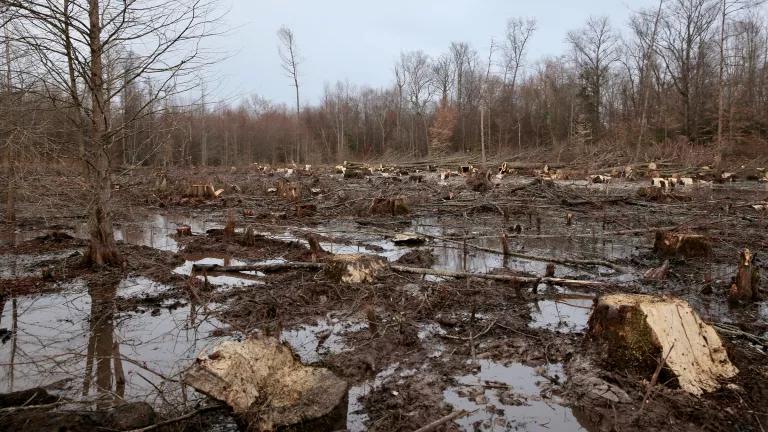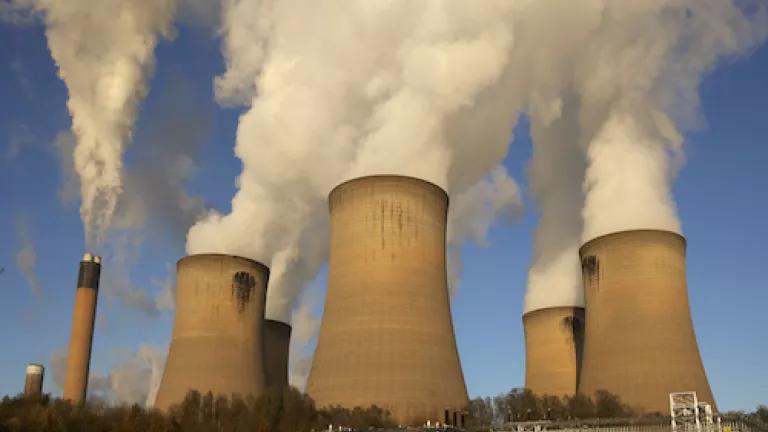UK Biomass Strategy Won't Stop Destruction of North American Forests
The UK Government's new Biomass Strategy won't do much to stop the ongoing flow of wood from North American, and European, forests to UK power stations.

A cypress tree stump in a clearcut section of northeastern forest
Dogwood Alliance
There has been over a year of waiting for the UK Government’s new Biomass Strategy. While we’ve waited, forests have been cut, shipped across the Atlantic, and burned—in the millions of tonnes.
At 204 pages it manages to say lots, while saying almost nothing at all. There is no new funding, and very little in the way of concrete changes to policy that we didn’t already know about.
While it blows hot improved “sustainability”, in reality this new Strategy will do nothing to stop the flow of wood from North American forests into the furnaces of UK power stations. It perpetuates the myth that the UK can simply rely on “sustainable forest management” overseas and that this is fine for nature and the climate.
The growing wood pellet industry, driven by UK demand, is damaging some of the most important forests landscapes on the North American continent, and the biodiversity they’re home to.
But the Strategy does hint at growing UK Government wariness of this industry by signalling that ideally the UK would shift away from burning wood pellets. After all, it’s an industry that has been beset by scandal and controversy since the start of this year:
- Bioenergy companies—like Drax—are repeatedly breaking air pollution limits and poisoning the air of communities of color in the US.
- Drax gamed the subsidy system to cheat the British public out of hundreds of millions of pounds that it should have handed back, in order to make a quick buck.
- Drax’s own scientific advisors questioned its use of “carbon neutral” to describe bioenergy.
- Drax is also under investigation by the UK’s energy regulator over its sustainability claims.
- The Government says it wants to “enhance” biomass sustainability criteria; but leaked documents showed that it is considering turning them from law into voluntary guidance.
Meanwhile, a Committee of MPs recently cautioned that the full lifecycle emissions of bioenergy (even with carbon capture and storage) need to be carbon neutral—recognising that the emissions caused by logging are sometimes ignored.
The bioenergy industry has shown time and again that its business model doesn’t work unless it makes false carbon neutral claims, cheats the British public out of hundreds of millions of pounds of their own money, destroys nature-rich forests, and poisons the air of vulnerable communities of color in the southeast US.
What does the new Biomass Strategy say?
The new Strategy promises improved sustainability standards. But it upholds the ongoing fallacy that burning wood from forests is carbon neutral because forests grow “quickly” and they have already absorbed some carbon. Labelling bioenergy as carbon neutral leaves someone else to deal with the problem - and really that’s the atmosphere.
Cutting down trees from forests dents their absorption and storage of carbon for decades to come. Even in countries where forests are recovering—which can mask these impacts—it means forests store less carbon than they would have done. The atmosphere experiences this as a climate impact, even if the numbers are fiddled on paper to look good.
There are six key points to draw from the Strategy:
- There is no new funding in the Strategy for bioenergy with or without carbon capture and storage.
- The Government’s modelling shows that by 2050 the UK may only have access to just over half the biomass it needs - this is a big and risky gamble with the UK’s energy security and with achieving net zero.
- There’s a plan for sustainability criteria for biomass across heat, power, and transport to be uniform. But there’s an ongoing mistaken assumption that if biomass is “sustainable” that means burning it doesn’t release any carbon dioxide.
- The Government’s plans are fairly conservative about the area of energy crops that will be grown in the UK - they see much lower amounts than the Climate Change Committee, for example. Instead they think the UK will remain much more dependent on imports of biomass. And this is very likely to mean ongoing imports of millions of tonnes of wood from North American forests.
- But the Government hopes that the supply of biomass is going to change: at the moment it’s mostly wood pellets. By 2025 the UK Government thinks it will be mostly agricultural residues and energy crops. This signals a clear scepticism over the role that wood from forests has to play. But the Strategy says nothing to explain where these will come from, how this shift will happen, nor why, if these sources are available, we’re not using them now instead of wood pellets. If the Government really wants to see a shift away from wood pellets, it needs to explain how this can happen.
- The Scientific Advisor’s report on Bioenergy with Carbon Capture and Storage acknowledges that there can be negative impacts on forest carbon stocks even if the bioenergy power plant has carbon capture technology.
- It says that there will be a transition away from burning biomass without carbon capture by 2035. A transition away does not mean an end, and this is a much later date than the Government’s climate advisors have proposed. This is an alarming back door for ongoing wood burning, without carbon capture, for another decade, and perhaps beyond.
- There is a whole chapter of the Strategy on air pollution. But it focuses exclusively on the risks in the UK. It does nothing to recognise the significant health impacts from air pollution caused by wood pellet mills, often located next to poor communities of color in the southeast US. These wood pellet mills only exist because of UK demand for biomass.
What happens next?
The Government looks set on pursuing Carbon Capture and Storage as a future option for cutting emissions by the late 2020s. The problem is that, when using Bioenergy, these “negative emissions” only exist on paper.
In the real world, and the atmosphere, cutting down trees reduces forests’ carbon absorption for years to come. The negative emissions only exist because carbon absorption by future trees, that don’t even exist yet, is factored into the calculations.
Despite this major drawback, the UK Government is considering new subsidy contracts for this Bioenergy with Carbon Capture and Storage. But that will be even more expensive than current conventional bioenergy. The industry itself says its number one concern for the future is the price and security of supply of wood pellets - global demand for wood is predicted to quadruple by 2050, meaning much greater competition for a finite supply of forests.
A single Bioenergy Carbon Capture power plant is predicted to need almost £32 billion in subsidies over 15 years - a cost likely to be borne by UK taxpayers. This would be a huge investment, with the cost of installing the equipment, and of the pipes to transport carbon dioxide to the North Sea coming on top. Even if it weren’t for its climate, nature, and human health impacts, it’s hard to see how BECCS makes economic sense.
The UK Government plans to review the sustainability standards for biomass, with a comment period coming soon. But the suggested areas for improvement will do nothing to address the fundamental carbon problems that are linked to burning forests with energy.
The Government also acknowledges that the UK is never going to grow many energy crops at home, instead it hopes it can find agricultural residues and energy crops from overseas. But bioenergy companies are putting all their chips somewhere else: they are building more and more of their own pellet mills, and buying wood pellet companies, in the US and Canada.
This is a Strategy that hedges, presents little in the way of concrete policy change, and acknowledges problems coming down the pike for bioenergy. It may not be long before we see the Biomass Strategy gathering dust on a shelf, while the UK Government prioritises energy technologies that it can afford, and that deliver real climate benefits.




